Frying pans: types, popular models and selection criteria
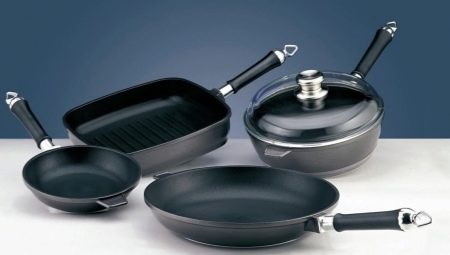
It is difficult to imagine both home and professional cuisine without a frying pan. This utensil allows you to prepare delicious crispy steaks, bake brown pancakes or indulge in a juicy vegetable stew. The main thing is to choose the right model of the frying pan, because each of these dishes requires its own version of the utensil.
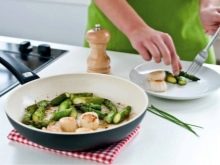
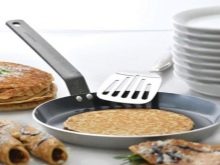
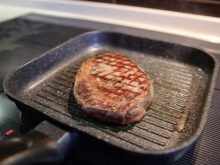
What it is?
A frying pan is a type of kitchen utensil. It is made of metal, in most cases it has a special coating. Despite the variety of options, all types of pans have one thing in common - thanks to the material they heat up and transfer this heat to food.
Typically, a frying pan has handles and a lid. In addition, modern models can be equipped with a temperature controller, a valve on the lid for steam release, and so on.
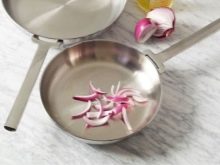
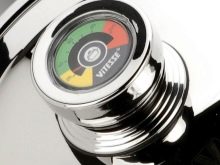
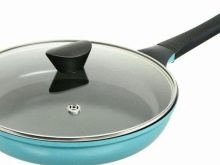
Views
Depending on the purpose of use, pans can be of several varieties.
- The roaster is designed for roasting meat, vegetables, fish and seafood, and is also suitable for frying and stewing. The main requirement is a thickened bottom and walls, due to which the brazier heats up quickly, distributes heat evenly, and stores it for a long time. The most suitable material is cast iron, and the manufacturing process itself is carried out using a special technology.
The brazier has a rather large weight and is characterized by reliability. Additionally, it can be equipped with a special press. Such a frying pan with a press is indispensable if you need to cook tobacco chicken.
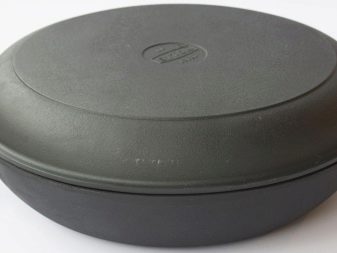
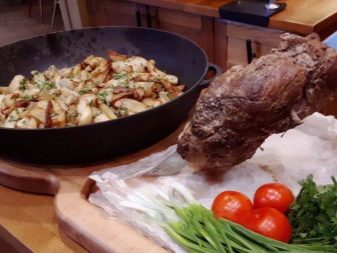
- Grill pan. Its distinctive feature is the ribbed bottom, imitating the surface of the lattice.Thanks to this design feature, food does not absorb oil and fat from the bottom of the pan, so the finished dish is healthier and healthier.

- Frying pan Wok. China is called the homeland of such utensils. Structurally, the wok is a cone-shaped dish with high walls and a small diameter bottom. The classic utensil has two handles. The vacuum pan is another variety of woks. It is equipped with a special lid, thanks to which it is possible to create a vacuum inside the pan. Thanks to the design, food particles cook quickly, forming a golden crust and remaining juicy on the inside.
Products for Woks need to be cut quite finely and the pieces must be mixed. The frying pan is suitable for cooking soups, as well as for frying, for paella, pilaf.
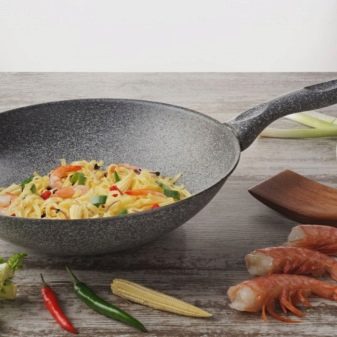
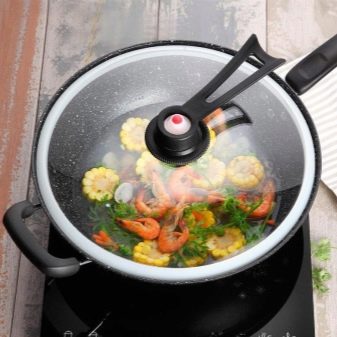
- Stewpan. This is a thick-walled pan and pot mix. The stewpan is distinguished by a thick bottom and sides, the latter being noticeably higher than those of conventional pans. The stewpan is optimal for languishing - cooking pilaf, stews, soups. It can have a special grid, then you get a full-fledged deep frying pan. The stewpan keeps the temperature for a long time, so the food stays warm for longer.
Due to the special relief of the bottom of the dishes, the food in it does not burn, it remains juicy. The stewpan can be used both on the stove and in the oven, there are stewpots for the barbecue.
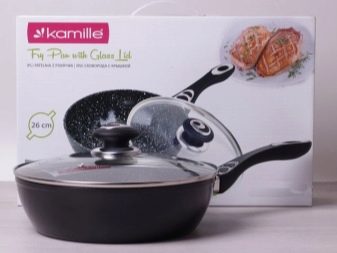
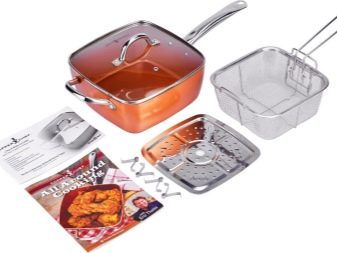
- Pancake. It is easy to identify by its compactness, light weight and low walls. Moreover, it has a rather thick bottom, capable of evenly heating up to high temperatures. A pancake pan usually has a handle that does not heat up. It can be of any shape, but more often it is round.
If we are talking about a special non-stick coating for such dishes, then it is permissible to bake pancakes and pancakes without using oil.
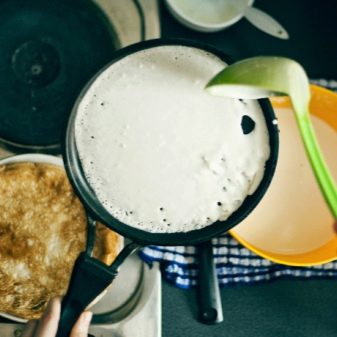
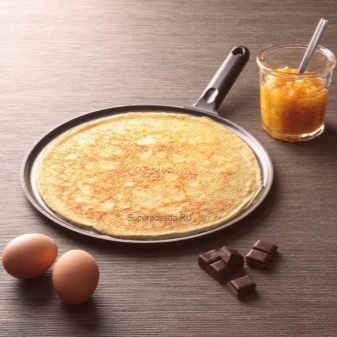
- Frying pan for fish. Usually, this pan is primarily distinguished by its shape - it is elongated so that whole fish carcasses can be positioned. It heats up quickly for crispy bites.
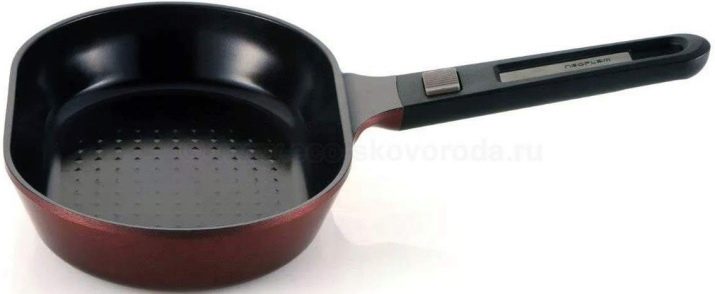
- The steamer pan allows you to cook healthy food. It is an utensil with an internal steam rack.

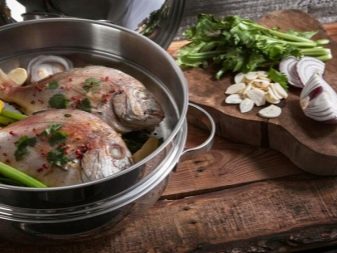
- Hazelnut, waffle iron. This is an utensil with a divider to receive halves of "nuts" for making sweets.
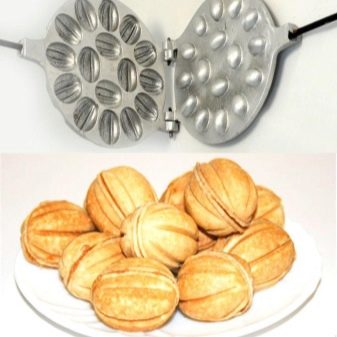
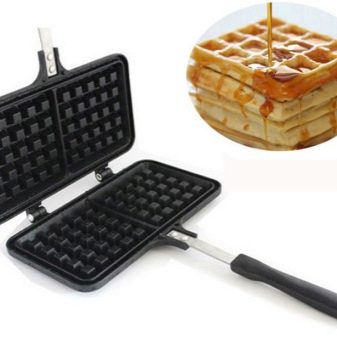
Materials (edit)
The types of pans can be determined by the types of material from which the dish is made. The most common are several materials.
Cast iron
The main advantage of a cast iron frying pan is its ability to evenly warm up over the entire surface, as well as maintain a high heating temperature for a long time. Food in such dishes does not burn, so it is optimal for simmering. Cast iron does not emit hazardous compounds during heating; moreover, food in the dishes is saturated with iron. Cast iron is quite simple to use. The utensils are allowed to be washed with detergents, they are not afraid of high and low temperatures. It is important to dry the pan well after washing, otherwise rust will appear on its surface.
One more point - periodically, cast iron must be calcined over a fire, lubricating it with oil and salt. This creates a natural non-stick coating on the surface and extends the life of the utensil. The durability of the frying pan should also be mentioned. But due to its heavy weight, it may not be convenient for everyone.
In addition, food cannot be stored in such a pan. Immediately after cooking, you should transfer food to special containers or enamel dishes.
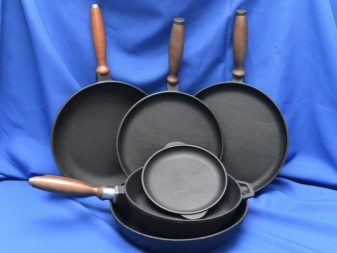
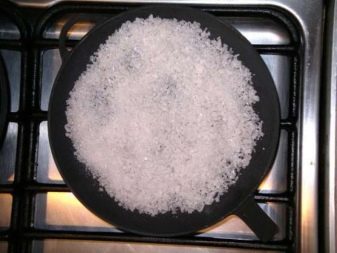
Aluminum
This is one of the affordable options. This frying pan heats up quickly, but the food in it starts to burn. It is important not to set the fire too high and stir the food from the bottom of the pan all the time. The paddle for stirring food should be made of silicone or wood, metal can scratch the aluminum surface. For cleaning utensils made of aluminum, it is unacceptable to use alkaline agents, as well as hard metal brushes. It is also impossible to store food in aluminum containers, as it oxidizes.
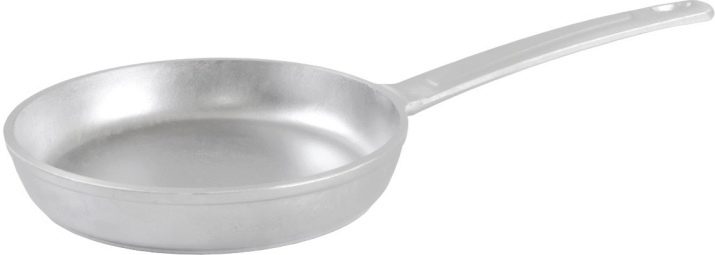
Stainless steel
The surface of such a pan heats up evenly and is able to retain heat for a long time, so it is suitable for cooking a wide variety of dishes - both fried and stewed. However, you should get used to cooking in such a pan - mix the food in a timely manner, warm up the oil for a long time, otherwise the food will stick to the surface and burn. Stainless steel is not suitable for frying eggs, pancakes, cheesecakes.
Stainless steel is a relatively unpretentious material in operation, which is also characterized by durability. It can be washed with almost any means, except abrasive ones.
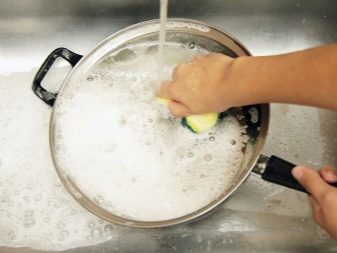
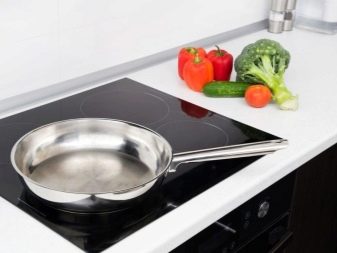
Copper
Copper utensils are always coated with stainless steel. It looks very impressive, suitable for cooking dishes that need to change the temperature during the cooking process. This is due to the fact that copper heats up and cools down quickly. However, this can simultaneously become difficulty in cooking. Another drawback is the high price, which many justify by its durability.
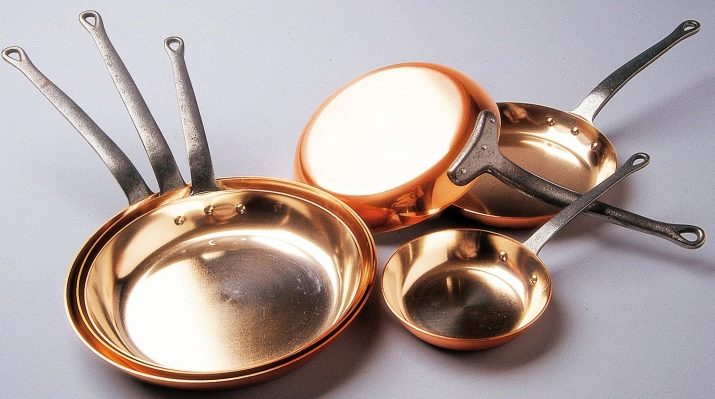
Coating types
There are several types of coatings.
Teflon
Another name is fluoroplastic 4 or polytetrafluoroethylene. Most often it covers aluminum pans. Teflon is a type of plastic that has high physical and chemical characteristics. It is highly durable, which ensures the longevity of the pan. However, the material should be protected from sharp objects.
Another advantage is food does not stick to this coating. Moreover, the process requires a minimum amount of oil. The layer itself is very durable, does not scratch, it is easy to wash off food debris. However, it is not suitable for high temperature heating... The optimum temperature for Teflon is + 200 ° C, otherwise the material will release carcinogens of little use. The exception is the widely advertised Tefal pans with Teflon coating, they are allowed to be heated up to + 260 ° C.
Important! Cookware with Teflon should not be overly light, as it deforms when heated.
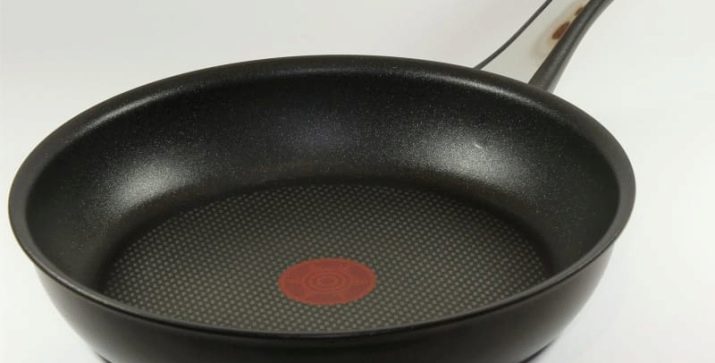
Marble
Under this coating is the already mentioned Teflon coating with the addition of marble chips. It turns out to be quite light, but thick-walled. The leading characteristics are uniform heating, heat retention. Unlike Teflon, the marble-coated counterpart is more durable - it suffers less from impacts and sharp objects.
In stores, you can find both expensive and cheaper options. However, quality utensils (with at least 3 layers of marble and a thick bottom) cannot be cheap. The highest quality products are considered to be with five layers of marble and a bottom thickness of 6 mm or more.
Manufacturers guarantee that such utensils will last at least 25 years.
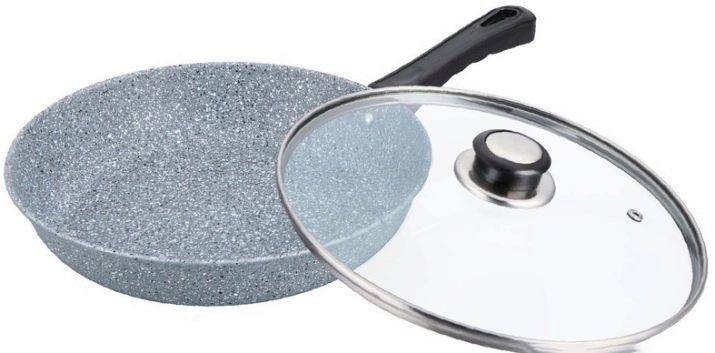
Ceramics
Another popular modern coating. Usually, aluminum and cast iron pans have a ceramic surface. The advantage of a ceramic surface is its ability to warm up quickly and evenly. Unlike Teflon, this coating can be heated up to + 450 ° C without emitting carcinogens.
It is optimal if you like foods with a golden brown crust. Even when removed from the heat, such a frying pan retains heat for a long time. A ceramic pan is less susceptible to mechanical damage than a Teflon pan. However, even such a coating can be damaged when dropped, scratched with metal forks and knives, spatulas.
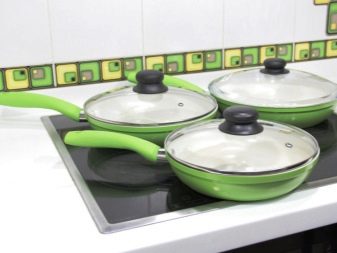
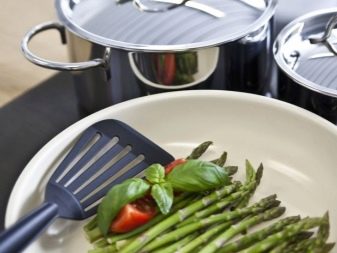
Ceramics is a material based on clay and mineral additives. The production process involves high-temperature heating and subsequent cooling of the product, which ensures its strength and durability. Only liquid consistency products are suitable for washing, as abrasives can damage the coating. Dishwasher safe. Damage to ceramics can also be caused by sharp temperature "jumps".
Important! A special feature of the ceramic pan is that it is not suitable for induction ovens.

Titanium
Titanium coating is considered environmentally friendly and safe. Such dishes are universal. It is suitable both for cooking delicacies with a golden brown crust and for stewing food. Titanium is characterized by strength and resistance to mechanical damage. It does not have any special requirements for the material of the scoop or spoons for mixing food. Finally, you can cook in such a pan without adding oil.
It is worth noting the higher cost of a titanium-coated frying pan, which pays off for its high performance characteristics and a longer period of operation.
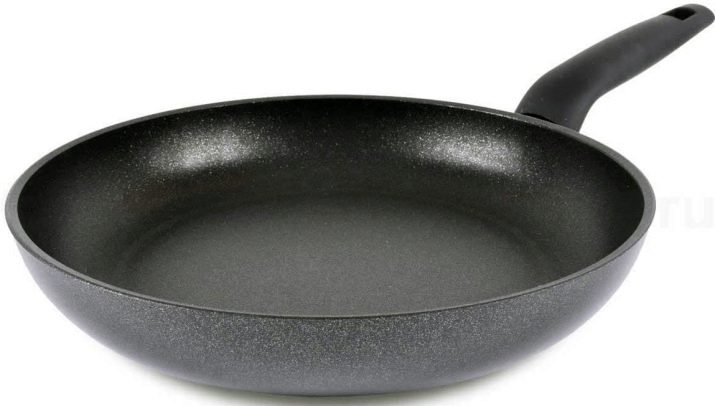
Enamel
Another safe material that prevents the pan's metal from oxidizing. This allows food to be cooked and stored in such a frying pan. Among the "disadvantages" of enamel coating are its fragility and instability. If chips or scratches occur on the surface, the dishes lose their inherent properties and require replacement. This is due to the need for a more careful approach to the type of spatulas, as well as gentle washing.
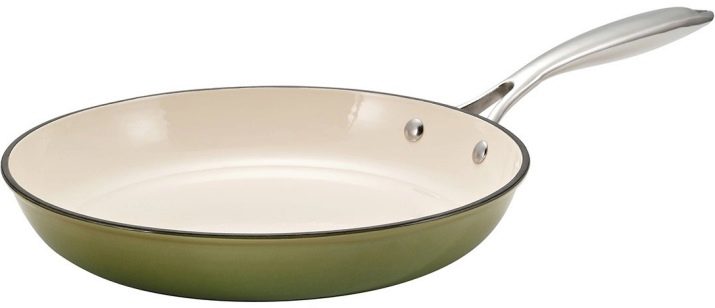
Shapes and sizes
The optimal size for a frying pan is 26–28 cm with a side height of 4–8 cm. It is clear that the pancake pan will be lower, and the saucepan - higher. The dimensions shown are standard, such a pan is suitable for both the stove and the oven. This frying pan is usually called classic.
The most typical grill pan is square or rectangular. The Wok frying pan has a round shape, but it cannot be confused with the classic one. It is distinguished by a small bottom and high sides. It seems as if the utensil is stretched up and expanding at the same time. An oval skillet is usually used for oven-baked dishes.
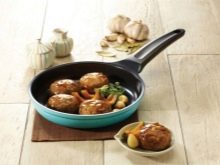
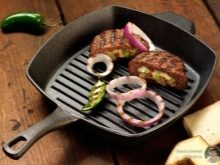
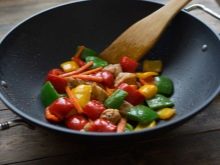
Model overview
Tefal
Among the most famous models of frying pans, one can single out the products of the Tefal brand. This French brand has more than 60 years of history, and the company's most famous product is the non-stick frying pan. The Tefal Meteor Ceramic model is popular and trusted by housewives and professionals. This is a ceramic coated stainless steel version. It is available in three sizes - 24, 26 and 28 cm.
An advantage can also be called the versatility of the utensils - it is suitable for all types of stoves (including induction). The optimum temperature for starting cooking is considered to be + 180 ° С... Thanks to the built-in temperature indicator, it's easy not to miss this moment.
The ceramic surface heats up evenly and thanks to its low porosity it is easy to clean.

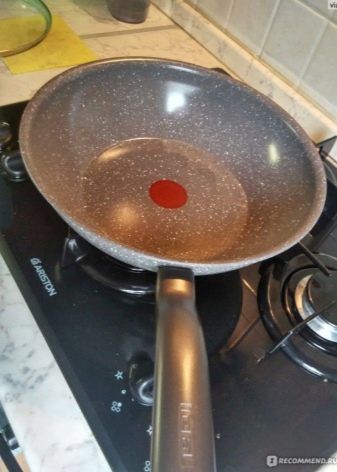
"Biol"
Frying pans from "Biol" (Ukrainian brand) are also widespread. Their main advantage is the presence of the German Greblon non-stick coating from Weilburger Coatings. The main products are aluminum cast pans, although the product line also includes cast iron models. A deep cast-iron frying pan with a removable handle is very popular among them from this manufacturer. All types of pans are available in three sizes - 24, 26, 28 mm.
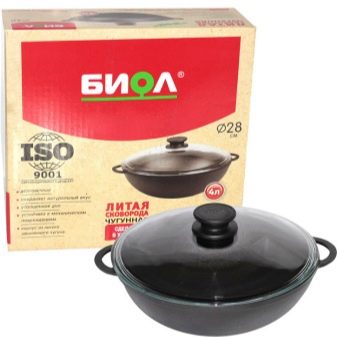

Rondell
If you are looking for the latest technology, pay attention to the frying pan from the German brand Rondell, in particular - the Flamme RDS-710 model. Thanks to the triple bottom, better temperature distribution is ensured and heating is held for longer. The non-stick coating has ceramic particles, which significantly increases the resistance of the product to mechanical damage. Another advantage is the thickened walls of the cookware.
It is suitable for all types of stoves, without harm to the product, it can be washed in the dishwasher.
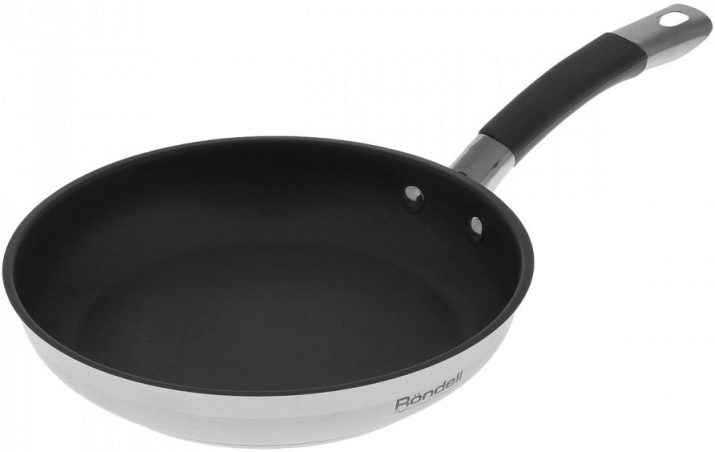
Gipfel
This German manufacturer is known for its high quality marble-coated stainless steel pans. However, the line also includes cast aluminum counterparts (for example, the Zenit deep frying pan with a double, outside and inside, non-stick coating).
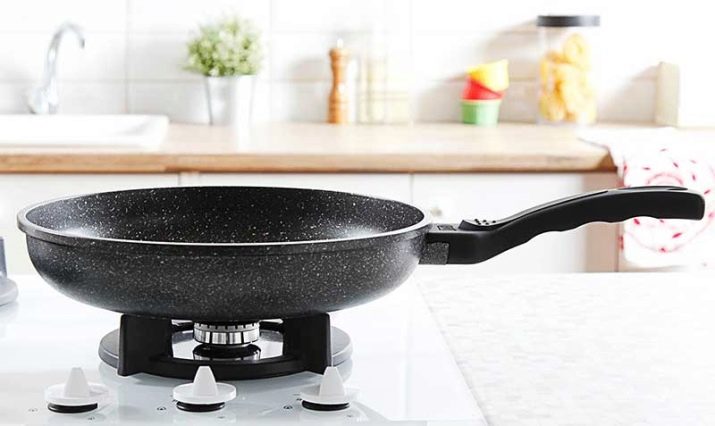
"Neva Metal Cookware"
Products from the domestic manufacturer "Neva Metal Posuda" (NMP) are practically not inferior in quality to foreign brands. The company "grew" out of a research institute, which makes it possible to talk about environmentally friendly production (in particular, all utensils are made without the use of perfluorooctanoic acid). Among the models in great demand is the Titan frying pan with a non-stick coating and thickened sides (4 mm thick) and bottom (6 mm thick).

Tima
This is another domestic brand. It is fair to say that Tima has products manufactured in conjunction with an Italian manufacturer (for example, Tima Titan Granit). This allows us to guarantee high quality products at fairly reasonable prices.
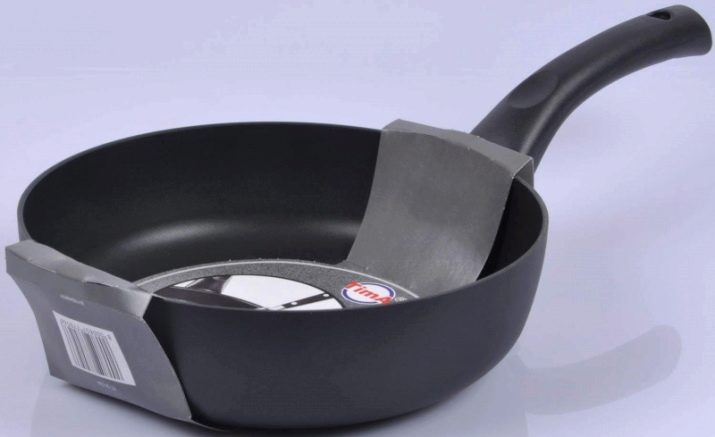
Supremo
Pans from the Chinese brand Supremo can be found in almost every major supermarket. The Wood & Stone series (wood and stone) is well known. It is a non-stick coated aluminum cookware. The frying pan got its name because of the imitation of a non-stick surface, metal chips and wooden handles. The product is produced with a diameter of 24 cm, a capacity of 4 liters. It is suitable for all types of slabs.
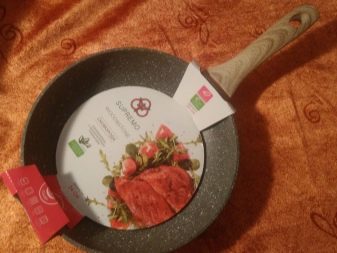
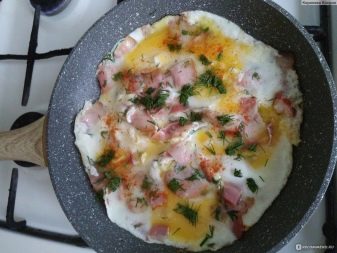
Criterias of choice
When choosing a frying pan, first of all, you should pay attention to the weight and thickness of the bottom and walls of the dishes. The greater the weight of the utensil, the more stable it will be on the stove and in the oven, and the less it will undergo deformation. If the choice is in front of relatively identical models, then preference should be given to heavier counterparts with a large number of non-stick layers.
An extremely thin frying pan will heat up quickly and the food in it will heat up. The optimum bottom thickness is 4–5 mm. Such a pan heats up quickly and well, the food in it remains juicy. Utensils that are too thin will heat up quickly and food will burn. Too thick bottom (more than 9-10 mm) will, on the contrary, heat up more slowly. In addition, such dishes will be unnecessarily heavy.
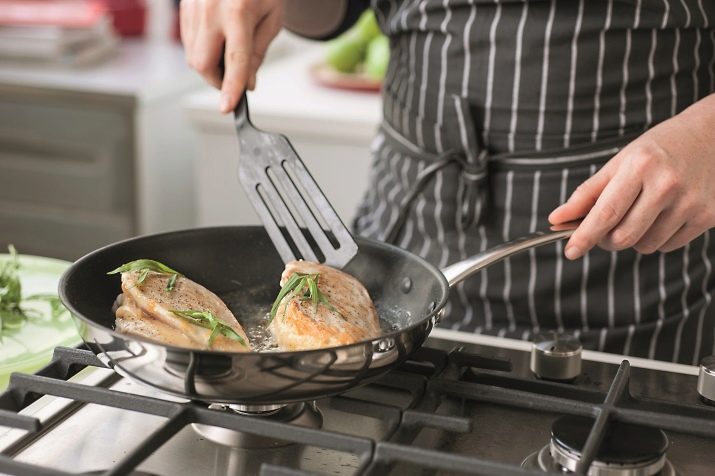
Of course, it is important to choose the utensils according to your goals. So, thick-walled pans should be chosen for vegetables, meat and fish. Good pancakes are made exclusively in special utensils. If it is not possible to purchase several pans at once, choose a more universal one, for example, a cast-iron version with rather high walls.
The next criterion is the size of the pan. It is important to consider here how much food and for how many people you plan to cook in the dishes. For one person, a frying pan with a diameter of 24 cm is enough. For a family of 3 or more people, you should purchase utensils with a diameter of 28 cm or more. Another factor is the size of the burners.
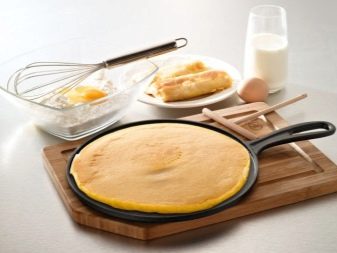
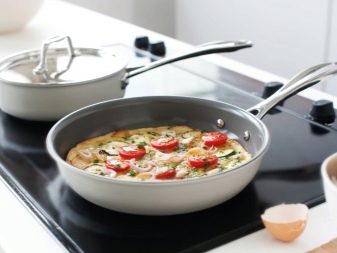
When choosing a frying pan with a Teflon coating, you should pay attention to the thickness of the bottom. The ideal aluminum frying pan should be cast with thick sides and bottom. If, nevertheless, a stamped aluminum frying pan is chosen, then it should be from the thickest sheets (at least 3 mm). The grill pan should have as high grooves on the bottom as possible, which will allow you to get more juicy and healthy food. For the oven, you should choose a frying pan with a removable handle. Another option is a non-removable metal handle with no plastic elements.
Today, when it comes to non-stick coatings, they usually speak of Teflon. However, it should be understood that this name is the name of the brand that manufactures such coatings. It would be more correct to say - PTFE-based non-stick coating. Among such coatings there is not only the famous Teflon brand, but also their main competitor - Whitford.
Important! A non-stick frying pan has a limited lifespan. On average, it is 1-3 years. It is imperative to change cookware with a non-stick coating, even if the latter is not damaged and has no visual changes.
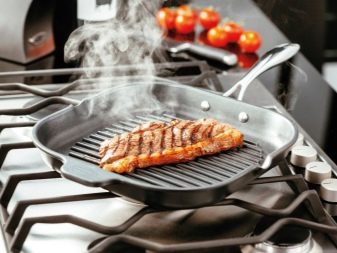
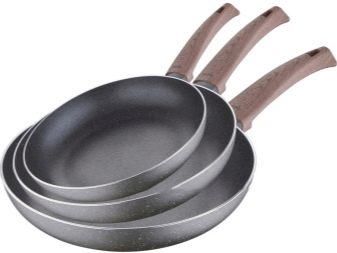
The surfaces of the utensils should be flat and smooth, without cracks, dents or bumps.Take the pan in your hand - is it comfortable to hold it by the handle, is it too heavy for you. For the electric stove, you should purchase utensils with a thick bottom.
Otherwise, there is a high probability of deformation of the slab. For gas stoves, you can choose a pan with a thinner bottom. If the cooker is induction, then all the dishes must be special - with magnetic properties. For a glass-ceramic hob, it is better not to buy copper or aluminum pans, as they will stain on such a surface.
Pay attention to the handle of the crockery. It can be solid or bolted. In the first case, the frying pan usually lasts longer, as the bolts can come loose. If you are looking for a more ergonomic storage option, opt for a frying pan with a removable handle. Convenient when the pan has a lid. Preference should be given not to metal, but to glass options with a stainless steel rim. More advanced lids have a steam release valve.
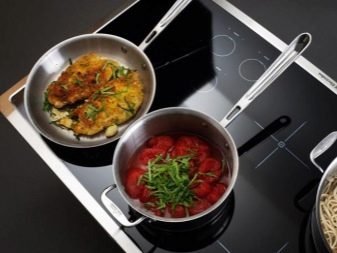
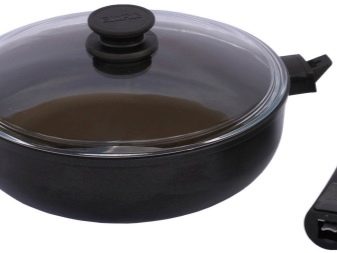
Care rules
Most pans, especially those with Teflon and ceramic coatings, do not tolerate the use of metal spatulas or stirring spoons. You will also have to give up hard brushes for washing, abrasive and dry powder detergents. Preference should be given to liquid, not too aggressive analogs. Even if the manufacturer claims that it can be cooked without vegetable oil, it is better to lubricate the surface of the pan at least a little, which will extend the life of the latter.
The Teflon coating heats up quite quickly, but is not designed for extreme heat. This should be borne in mind during the cooking process. The exception is non-stick teflon-coated pans.

For information on how to choose a frying pan, see the next video.








